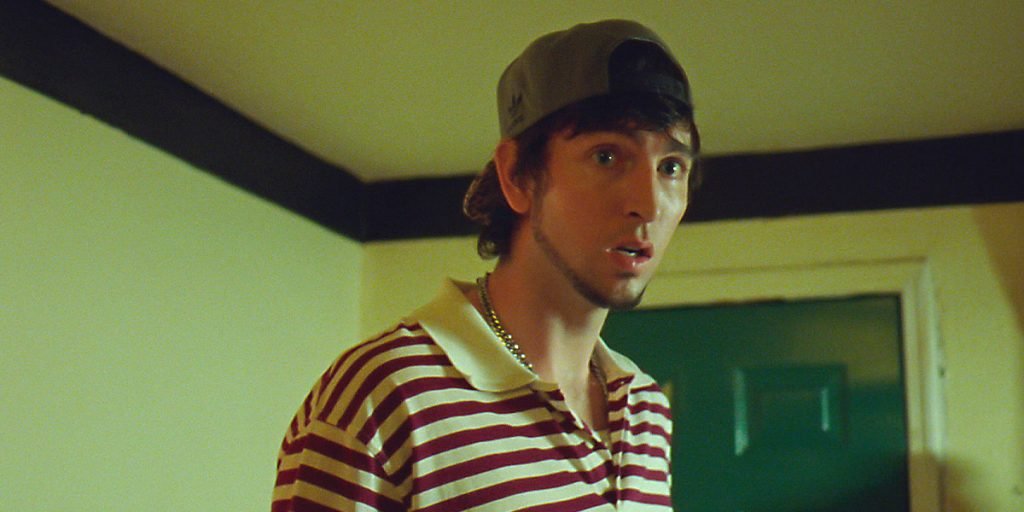A24’s Zola provides a thrilling story about sex work and social media but doesn’t shy away from displaying male masculinity as stereotypical.
Initially premiering at the 2020 Sundance film festival, Zola was one of the most talked-about films during that time. Based on a series of tweets from Aziah “Zola” King, this film tells the true tale of a weekend of stripping in Florida that goes absolutely wild. Throughout this film’s 87 minute runtime, viewers are taken on a journey that is filled with sex, violence, and enough twists and turns to make anyone dizzy. Even though this story is about female strippers at its core, when I first saw Zola in the summer of 2021, I was mainly astounded by the representation of masculinity portrayed, specifically male masculinity.
Before I discuss the representation of masculinity in Zola, let’s familiarize ourselves with the four central characters in this story. Zola, played by Taylour Paige (Ma Rainey’s Black Bottom), is our level-headed protagonist which we see the whole film through. She is not afraid to speak her mind and is how we, the viewers, are able to ground ourselves on this thrilling ride. On the other hand, Stefani, played by Riley Keough (The Devil All the Time), is the unpredictable new friend of Zola’s who seduces her into going to Florida for the weekend to strip. Both of these women are accompanied by X and Derek. X, played by Colman Domingo (Euphoria), initially seems to be a fun guy who’s here to hang for the weekend, until it’s discovered that he is Stefani’s pimp and will do whatever is necessary to get what he wants. Derek, Stefani’s obsessive yet harmless boyfriend, is played by Nicholas Braun (Succession) and is just along for the ride, never getting a say in what goes on, even if it puts him or his girlfriend in danger.
If you watch Zola, one of the main aspects that you can pick up on is how drastically different each and every central character is from one another. As for the male characters in this film, each of them could not be more different from the other. Starting off with physicality, Derek is a skinny man that dresses in “urban” clothing which makes him come off as extremely non-threatening. As for X, he is an extremely muscular man seen in clothing that compliments his strong masculinity and can be seen as physically dominating. The physical presentation of these characters was not only supposed to showcase the characters’ personalities but also provide some commentary as to how masculine these characters really are.

 loudandclearreviews.com
loudandclearreviews.comMoving onto the personalities of these two characters, once again both Derek and X couldn’t be more different from each other. Almost any time Derek talks, he is not only ignored but also insulted for even trying to voice his opinion. When there is any type of conflict of interest with Derek, he never stands up for himself, but rather sits there and takes the insults, even if that means getting a door literally slammed in his face. On the other hand, any time that X is faced with any type of conflict, if he is not able to verbally get himself ahead, he uses his dominating physicality to do so. This can be seen specifically in the poolside scene with both X and Zola.
At this point in the film, Zola has realized that she is not in Florida just to strip but to be a part of a prostitution ring. Feeling understandably overwhelmed, she leaves Stefani, whom she just spent the night with, and goes to relax by the pool. Early into her relaxation period, X comes to praise Zola for her efforts from the night before and tells her that she will be needed again that following night. When Zola tries to tell X that she is not about this life and that she needs to leave, he grabs her face, showcasing his masculinity by utilizing his dominating physicality, and reminds Zola that she is under his control.
At this point, you may be thinking, ”Why do these representations of masculinity even matter in a female-centered film like Zola?” Even though Zola is a female-driven narrative, the representation of masculinity still matters. This film in particular showcases polarized performances of masculinity which contribute to a stereotype that men can only be one of two things: ultra-masculine and dominant like X, or nonmasculine and submissive like Derek. As most of us see in our everyday lives, masculinity comes in all shapes and forms. You could see someone who looks stereotypically masculine, wearing athletic clothing and being muscular, and, from these features alone, many of us would naturally make assumptions about this person, them having a deeper voice or being overtly confident.
However, many times they won’t necessarily fit all of these standards. Even though the performance of male masculinity is an important issue, I believe that, as a society, we are able to understand that masculinity is a spectrum. Just because you look a certain way, it doesn’t mean you have to act a certain way. My issue with Zola isn’t about the presentation of masculinity as a whole in modern times, but, instead, about the way that media represents male masculinity. It is as if we have our understanding of male masculinity modernized, but in media representations such as Zola it seems as if we are still in the past.
Zola is just one example of a greater issue that the media has in regards to the presentation of male masculinity, and it spans across all genres. For more context, let’s look at Jumanji: Welcome to the Jungle. Dwayne Johnson’s character Spencer is seen as extremely muscular and is the leader of the group. There are even jokes that he has a special smolder, which is meant for intimidation.
On the other hand, if we take Jack Black’s character, Bethany, there is almost no comparison that can be made to Spencer. Starting off with the female name of Bethany, the list of submissive or more feminine qualities could span across his more formal clothing, while the other characters have on more athletic outfits, his larger body proportions while everyone else is more fit, and his higher tone of voice. Even though it is seen quite differently in Jumanji: Welcome to the Jungle than Zola, the same stereotype is present. Spencer is the strong brave leader because he looks the part, while Bethany is the clear follower and is rarely appreciated in the whole movie, because of the way he looks.

The issue with this polarization of masculinity presentation in media runs deeper than most consumers think. Every day, we look at media, whether we know it or not. Everything that we see influences how we think. Let’s take the classic film Jaws, for example. Right after that movie came out, across the country, there was an immense decrease in people going to the beach. This is because people consumed the media, and it told them how to think, making them afraid of the beach all of the sudden. In Zola’s case, this particular presentation of masculinity has the capability to make us consumers believe that these presentations are the only two options. If someone has the body type of X, they must be an overtly dominant figure, and if they look like Derek, they must be not able to stand up for themselves.
So what do we do with this issue now? The best way to combat this is to enable creators to share stories where males are able to be perceived as masculine without having all of the negative traits associated with strong masculinity, and vice versa. One of the best examples of combating this issue is HBO Max’s second season of Love Life. In this anthology series, we follow Marcus Watkins (Willam Jackson Harper) through a series of relationships during his adult life. What Love Life manages to do so brilliantly is maintain Marcus’ masculinity and sex appeal, without sacrificing any vulnerablity that is required for a male-led romance show. Marcus has a six-pack and is clearly wanted by all types of people, but he is still able to wear his heart on his sleeve and make mistakes without being seen as toxic.
Even though season two of Love Life is a great step forward in male masculinity representation, it is important to note that Harper’s performance is in a leading role, while, in Zola, these characters are supporting. This means that Love Life has room for viewers to get to know and understand Marcus, while in Zola there is simply no space for the character development that would break both X and Derek our of their current stereotype. Since Zola isn’t primarily about X and Derek, creators just resorted to portraying masculinity on whatever end of the spectrum that best suits the story, reinforcing the stereotype.
If there is one important take away that I hope you can get out of this article, it is to be aware of representation of male masculinity, even in supporting forms. We are so used to seeing stereotypes of almost any identity that we have become blind to it, and even though we are getting better at recognizing these stereotypes, masculinity hasn’t been given the spotlight it deserves. With all that being said, I encourage you to be on the lookout for pieces of media that break these stereotypes of male masculinity, and when you find them, give them the recognition they deserve. As with anything, the more people that are aware of an issue, and highlight solutions to it, the more the culture will change.
Zola was released in US theaters on June 30, 2021 and is now available to watch on digital and on demand everywhere. Read our review of Zola.

